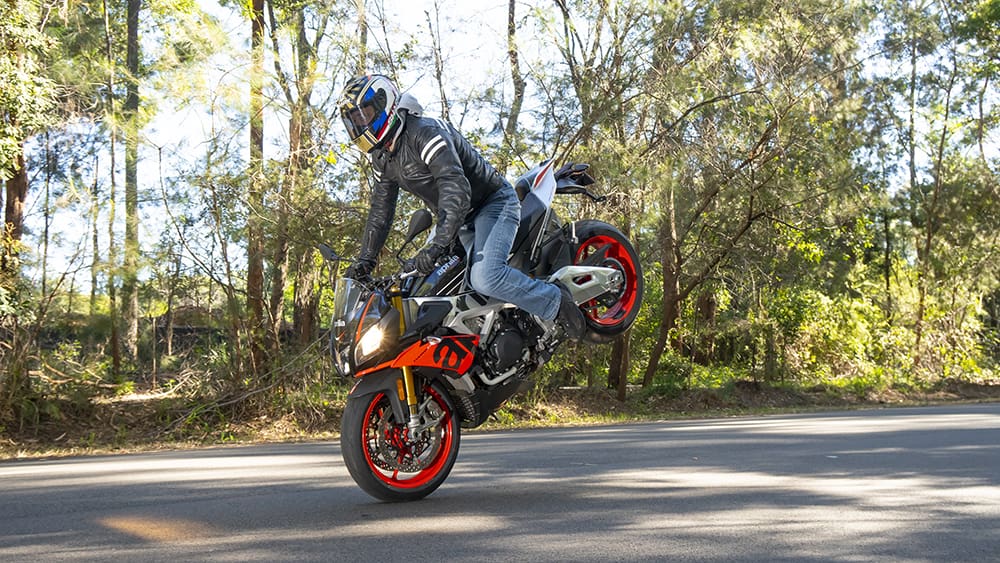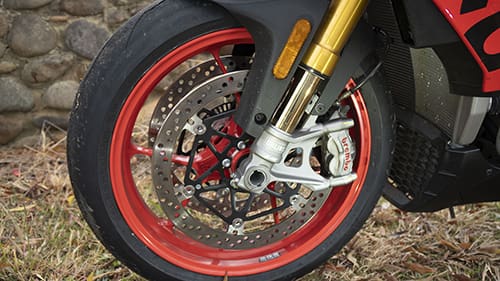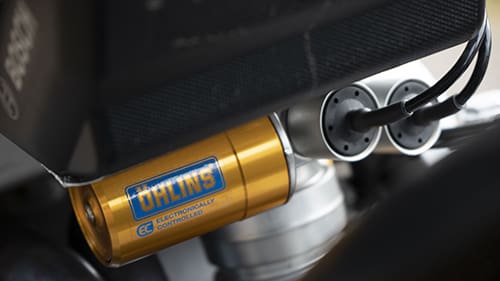We’ve already track thrashed this beast – but how do the superb new chassis manners translate to the road?
Aprilia was always going to back its new Tuono 1100 Factory on the racetrack – it already knew the 1077cc V4 could make short work of any track in Oz, and the major new point for 2019, Aprilia Suspension Control in the form of the semi-active Öhlins Smart EC 2.0 suspension, easily dealt with the relatively smooth confines of Sydney Motorsport Park. The g-forces are up, but the hotmix is less challenging – so how does it handle the reality of Australian roads?
Not long after we burned a set of Pirellis at the national launch (Vol 68 No 22), we wrestled our way to the front of the queue to ride this thing on the road, with two weeks to do so.
We know the new Tuono can stitch a set of race corners together lap after lap, but we also know the whole point of a naked bike is to be a pleasure to live with on the road, too, without the riding position of more sport focused faired bikes – like its 217hp RSV4 1100 Factory stablemate, for instance.
At the track, getting on the bike while still on stands, and not needing to put my foot down much, the tall seat height isn’t much of a problem. At 178cm tall, though, the Tuono Factory is a fair vault to the 825mm seat and for anyone much shorter than me, it could be annoying for those not comfortable manoeuvring with their feet on the pegs. Once the V4 barks into life, however, snapping passersbys’ necks in the process, all is forgiven.
As punchy and responsive as the V4 is on the track, its low-rpm manners and instant snap makes road riding a glorious path to open-road nirvana, yet it handles the daily grind with aplomb as well. It also does it without the heat generation of other V4s, such as the Ducati Panigale V4 S.
We knew this about the engine, though. How does the ASC work in the real world, and how easy is it to use?
The system runs Active and Manual modes, allowing you to set and forget in Active mode, with some parameter adjustment while you are at it, or tune it to a standstill yourself.
Having ridden it on the road now, I can suggest a few things with this suspension. I first have to say I am not an ‘auto mode’ rider. I prefer a manual car (when I have to drive one), I use manual settings on a camera and never watch anything Netflix reckons I’d like.
It’s not just that I am a control freak, it’s also that auto modes generally frustrate me – they are inaccurate, generic and too vanilla. I’d simply rather the extra effort of manual modes and just get the job done properly. With the Tuono Factory ASC, though? Yeah, nah. Just use Active mode. It’s amazing.

Getting to it isn’t too confusing either, and soon after getting back onboard, I was okay finding my way through to the APRC settings via the ’bar-mounted switch on the left, then the ASC menu. Within that, I headed for A3, the Active Road mode, alternatives being Active Track and Active Sport. Having spent time in the Track mode at SMSP, I wanted to see how comfortable and compliant a naked 130kW (175hp) animal can be.
I did fear the compromise I expect from any automated system – have you tried ringing Telstra lately? – and was expecting to be diving for the M3 Manual road setting as soon as I could. The manual settings allow you to set compression and rebound damping as you would on any adjustable suspension, the difference being you use electronic screwdrivers, rather than getting your hands dirty.
Instead, the kays began to mount up and up, and the bike just kept ironing out the road in front of me, maintaining the high level steering feel and response, keeping the comfort level where I expected it to be on a bike so potent. Better, actually.
Within the A3 settings, you can adjust damping parameters, remembering the Smart 2.0 system is adjusting as it goes, reading the sensors 1000 times a second and making adjustments up to 10 times a second in response to what the wheels are doing. Changing the parameters in which it operates is therefore difficult to decipher, given all the action, but I slowed it down a tad to -2 on front and rear firmness settings, -1 on brake support and acceleration support, 0 on mid corner support and steering damping.
You need to remember minus numbers are actually more damping – this is the reversal of conventional systems and easy to stuff yourself up, therefore.
Once sorted, I never felt the need to touch it. Wet commuting, dry back-road thumping and everything in between and I had a compliant, responsive corner monster that eats potholes and crap surfaces, lets me brake hard for corners or errant drivers and still lets me bury the bike’s nose deep into rider roads.


It’s not 100 percent magic carpet. Bumps will still affect it and you can feel damping changing between different road scenarios. The difference is that the bike will keep the response consistent and its weight settled when it does get choppy. It’s that consistent response I get the most out of.
You just know the bike will behave a certain way 90 percent of the time as the fork, shock and steering damper work to keep the bike within the parameters you’ve set, despite the road trying to make that as difficult as possible.
Knowing I had the wheels beneath me being controlled that way, I found myself enjoying the ride a lot more, not to mention the fact I had dialled in the plushness a crappy Aussie road needs, without ruining the sportiness of one of the best roadbikes you can buy. Yep, I said that.
The manual mode works well too, I just found the Active modes work better on the variety of surfaces you travel on the public road. I also know from experience that many road riders simply don’t want to touch the suspension much, other than a basic set and forget. If that. On this bike, though, you can do that and ride happily, pretty much anywhere. And it doesn’t just do a mediocre job of it either – it is a magnificent ride.
The riding position is on the sporty side of naked and the relatively tall seat height aside, the rest of the bike’s road pedigree is close to flawless. I like the new styling, too, though I know it’s not for everyone. Can’t see it when you’re riding it, as I always say.
Would I pick the $27,190 Factory over the standard $23,490 RR Tuono and its ‘old fashioned’ conventional Sachs boingers? That depends how rich I am, of course, but I certainly want to. It makes the potency of that amazing engine even easier to access, the shift from roadbike to track-day weapon just a few button pushes (four, in fact) and the ability to easily shift parameters with the adding and subtracting of weight and luggage.
Importantly, it remains close, price-wise, to its biggest rival, the KTM 1290 R Super Duke ($26,795), with conventional suspension. Which would I pick? Hard one, as an ex-Super Duke owner – I’d have to ride them back-to-back to know for sure, but that suspension package adds considerable weight to usability and value for money for the Tuono.
Niggles are minor in road use, components such as the TFT dash, sidestand and seat comfort (if not height) are all easy to live with day to day, and the sound that V4 engine makes in anger needs to heard by all motorcyclists to understand just how good internal combustion can sound.

TEST: SAM MACLACHLAN PHOTOGRAPHY PETE VORST